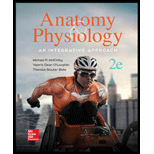
Anatomy & Physiology: An Integrative Approach
2nd Edition
ISBN: 9780078024283
Author: Michael McKinley Dr., Valerie O'Loughlin, Theresa Bidle
Publisher: McGraw-Hill Education
expand_more
expand_more
format_list_bulleted
Concept explainers
Question
Chapter 4, Problem 11DYKB
Summary Introduction
To describe:
The general structure and function of the three major structures of a cell.
Concept introduction:
Cell is a functional and structural unit of all living organisms and makes the basic building block for the body. Each type of cell performs specific functions; disposal of waste product, maintenance of shape and integrity of the cell, and obtaining nutrient from its surrounding fluids.
Expert Solution & Answer
Want to see the full answer?
Check out a sample textbook solution
Students have asked these similar questions
Describe the structure of a cell and its components.
identify the 3 major regions found in a cell. Explain the functions of each region.
Identify the three main parts of a cell, and list the general functions of each.
Chapter 4 Solutions
Anatomy & Physiology: An Integrative Approach
Ch. 4.1 - What is the advantage of using a TEM instead of an...Ch. 4.1 - Prob. 2WDYLCh. 4.1 - What are the three main structural features of a...Ch. 4.2 - What cellular structure is responsible for forming...Ch. 4.2 - How do lipids maintain the basic physical barrier...Ch. 4.2 - What type of plasma membrane protein provides the...Ch. 4.3 - How does O2 diffuse into a cell and CO2 diffuse...Ch. 4.3 - Compare and contrast how an ion is transported...Ch. 4.3 - Define osmosis.Ch. 4.3 - What occurs to the tonicity of a cell when it is...
Ch. 4.3 - What general conclusion can you make concerning...Ch. 4.3 - What transport process involved in the movement of...Ch. 4.3 - Engulfing of a bacterium by a white blood cell...Ch. 4.4 - Define a resting membrane potential.Ch. 4.4 - Explain how the resting membrane potential is...Ch. 4.5 - What are some examples of how cells communicate...Ch. 4.5 - How do action of enzymatic receptors and G...Ch. 4.6 - Describe the general structure of both the...Ch. 4.6 - Lysosomes and peroxisomes are both small...Ch. 4.6 - Which non-membrane-bound organelle functions (a)...Ch. 4.6 - Which cellular surface structure functions in (a)...Ch. 4.6 - Which cellular junction (a) provides resistance to...Ch. 4.7 - What is the function of nuclear pores within the...Ch. 4.7 - What is the function of the nucleolus?Ch. 4.7 - Describe the structural relationship of DNA and...Ch. 4.8 - What are the three major structures required for...Ch. 4.8 - What is a codon and an anticodon?Ch. 4.8 - How is mRNA attached to ribosomes and translated...Ch. 4.8 - The genetic code of DNA is the specific...Ch. 4.9 - How is chromatin distinguished from a chromosome?Ch. 4.9 - Describe the process of DNA replication that...Ch. 4.9 - What are the events that occur during the mitotic...Ch. 4.10 - What are the specific changes that occur to DNA...Ch. 4 - All of the following general functions are carried...Ch. 4 - _____ 2. The molecule that is responsible for most...Ch. 4 - Prob. 3DYKBCh. 4 - Prob. 4DYKBCh. 4 - Prob. 5DYKBCh. 4 - Prob. 6DYKBCh. 4 - Prob. 7DYKBCh. 4 - Prob. 8DYKBCh. 4 - _____ 9. During this stage of mitosis, the...Ch. 4 - _____ 10. Erythrocytes do not have a nucleus. In...Ch. 4 - Prob. 11DYKBCh. 4 - Prob. 12DYKBCh. 4 - Describe the passive processes of membrane...Ch. 4 - Describe the active processes of membrane...Ch. 4 - List the membrane-bound structures, and describe...Ch. 4 - Prob. 16DYKBCh. 4 - Prob. 17DYKBCh. 4 - Prob. 18DYKBCh. 4 - Prob. 19DYKBCh. 4 - Explain the processes that occur in the different...Ch. 4 - Michael was born with Tay-Sachs disease. Which of...Ch. 4 - Prob. 2CALCh. 4 - Prob. 3CALCh. 4 - Prob. 4CALCh. 4 - Prob. 5CALCh. 4 - Prob. 1CSLCh. 4 - Prob. 2CSLCh. 4 - Prob. 3CSL
Knowledge Booster
Learn more about
Need a deep-dive on the concept behind this application? Look no further. Learn more about this topic, biology and related others by exploring similar questions and additional content below.Similar questions
- List the functions of the cell nucleus and explain how thesefunctions arise from its structurearrow_forwardIn the cell there are three types of filaments that form the cell skeleton. Answer:a)Which they are.b)How they are constructed.c)What their function is.arrow_forwardDescribe the structure and the function of the plasma membrane.arrow_forward
arrow_back_ios
arrow_forward_ios
Recommended textbooks for you
 Human Physiology: From Cells to Systems (MindTap ...BiologyISBN:9781285866932Author:Lauralee SherwoodPublisher:Cengage Learning
Human Physiology: From Cells to Systems (MindTap ...BiologyISBN:9781285866932Author:Lauralee SherwoodPublisher:Cengage Learning

Human Physiology: From Cells to Systems (MindTap ...
Biology
ISBN:9781285866932
Author:Lauralee Sherwood
Publisher:Cengage Learning
Biology - Intro to Cell Structure - Quick Review!; Author: The Organic Chemistry Tutor;https://www.youtube.com/watch?v=vwAJ8ByQH2U;License: Standard youtube license